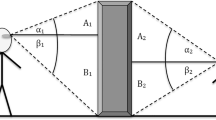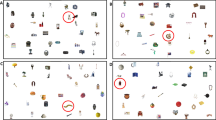Abstract
The present study assessed preferential attentional processing of animal fear-relevant stimuli in two procedures, Search and Interference tasks, which have been suggested to reflect on attentional capture due to the fear-relevance of the stimuli presented. In the Search task, participants (N = 154) searched fear-relevant (i.e., snakes and spiders) and non fear-relevant (i.e., fish and birds) backgrounds to determine the presence or absence of a deviant animal from the opposite category. In the Interference task, the same participants searched for the presence or absence of a neutral target (a cat) when either a snake, spider or no distracter were embedded amongst backgrounds of other animal stimuli. Replicating previous findings, preferential attentional processing of animal fear-relevant stimuli was evident in both procedures and participants who specifically feared one animal but not the other showed enhanced preferential processing of their feared fear-relevant animal. However, across the entire sample, there was no relationship between self-reported levels of animal fear and preferential processing which may reflect on the fact that substantial preferential attentional processing of fear-relevant animals was evident in the entire sample. Also, preferential attentional processing as assessed in the two tasks was not related. Delayed disengagement from fear-relevant stimuli appeared to underlie performance in the search task but not in the interference task.


Similar content being viewed by others
References
Bar-Haim, Y., Lamy, D., Pergamin, L., Bakermans-Kranenburg, M. J., & van IJzendoorn, M. H. (2007). Threat-related attentional bias in anxious and nonanxious individuals: A meta-analytic study. Psychological Bulletin, 133, 1–24.
Duncan, J., & Humphreys, G. W. (1989). Visual search and stimulus similarity. Psychological Review, 96, 433–458.
Eastwood, J. D., Smilek, D., Oakman, J. M., Farvolden, P., van Ameringen, M., Mancini, C., et al. (2005). Individuals with social phobia are biased to become aware of negative faces. Visual Cognition, 12, 159–179.
Fox, E., Lester, V., Russo, R., Bowles, R. J., Pichler, A., & Dutton, K. (2000). Facial expressions of emotion: Are angry faces detected more efficiently? Cognition and Emotion, 14, 61–92.
Gerdes, A. B. M., Alpers, G. W., & Pauli, P. (2008). When spiders appear suddenly: Spider-phobic patients are distracted by task-irrelevant spiders. Behaviour Research and Therapy, 46, 174–187.
Gilboa-Schectman, E., Foa, E. B., & Amir, N. (1999). Attentional biases for facial expression in social phobia. Cognition and Emotion, 13, 305–318.
Hadwin, J. A., Donnelly, N., French, C. C., Richards, A., Watts, A., & Daley, D. (2003). The influence of children’s self-report trait anxiety and depression on visual search for emotional faces. Journal of Child Psychology and Psychiatry, 44, 432–444.
Horstmann, G., Scharlau, I., & Ansorge, U. (2006). More efficient rejection of happy than of angry face distractors in visual search. Psychonomic Bulletin & Review, 13, 1067–1073.
Klorman, R., Weerts, T. C., Hastings, J. E., Melamed, B. G., & Lang, P. J. (1974). Psychometric descriptions of some specific fear questionnaires. Behavior Therapy, 5, 401–409.
Lipp, O. V. (2006). Of snakes and flowers: Does preferential detection of pictures of fear-relevant animals in visual search reflect on fear-relevance? Emotion, 6, 296–308.
Lipp, O. V., Derakshan, N., Waters, A. M., & Logies, S. (2004). Snakes and cats in the flowerbed: Fast detection is not specific to pictures of fear-relevant animals. Emotion, 4, 233–250.
Lipp, O. V., & Waters, A. M. (2007). When danger lurks in the background: Attentional capture by animal fear-relevant distracters is specific and selectively enhanced by animal fear. Emotion, 7, 192–200.
LoBue, V., & DeLoache, J. S. (2008). Detecting the snake in the grass. Attention to fear-relevant stimuli by adults and young children. Psychological Science, 19, 284–289.
Lundqvist, D., & Öhman, A. (2005). Emotion regulates attention: The relationship between facial configuration, facial emotion, and visual attention. Visual Cognition, 12, 51–84.
Mathews, A., & Mackintosh, B. (1998). A cognitive model of selective processing in anxiety. Cognitive Therapy and Research, 22, 539–560.
Miltner, W. H. R., Krieschel, S., Hecht, H., Trippe, R., & Weiss, T. (2004). Eye movement and behavioral responses to threatenting and nonthreatening stimuli during visual search in phobic and nonphobic subjects. Emotion, 4, 323–339.
Mineka, S., & Öhman, A. (2002). Phobias and preparedness: The selective, automatic, and encapsulated nature of fear. Biological Psychiatry, 52, 927–937.
Mogg, K., & Bradley, B. P. (1998). A cognitive-motivational analysis of anxiety. Behaviour Research and Therapy, 36, 809–848.
Öhman, A. (1993). Fear and anxiety as emotional phenomena: Clinical phenomenology, evolutionary perspectives, and information processing mechanisms. In M. Lewis & J. M. Haviland (Eds.), Handbook of emotions. New York: Guilford.
Öhman, A., Flykt, A., & Esteves, F. (2001a). Emotion drives attention: Detecting the snake in the grass. Journal of Experimental-Psychology: General, 130, 466–478.
Öhman, A., Lundqvist, D., & Esteves, F. (2001b). The face in the crowd revisited: A threat advantage with schematic stimuli. Journal of Personality and Social Psychology, 80, 381–396.
Öhman, A., & Mineka, S. (2001). Fears, phobias, and preparedness: toward an evolved module of fear and fear learning. Psychological Review, 108, 483–522.
Purcell, D. G., Stewart, A. L., & Skov, R. B. (1996). It takes a confounded face to pop out of a crowd. Perception, 25, 1091–1108.
Rinck, M., Reinecke, A., Ellwart, T., Heuer, K., & Becker, E. S. (2005). Speeded detection and increased distraction in fear of spiders: Evidence from eye movements. Journal of Abnormal Psychology, 114, 235–248.
Spielberger, C. D., Gorsuch, R. L., Lushene, R., Vagg, P. R., & Jacobs, G. A. (1983). Manual for the state-trait anxiety inventory. Palo Alto: Consulting Psychology Press.
Tipples, J., Atkinson, A. P., & Young, A. W. (2002a). The eyebrow frown: A salient social signal. Emotion, 2, 288–296.
Tipples, J., Young, A. W., Quinlan, P., Broks, P., & Ellis, A. W. (2002b). Searching for threat. The Quarterly Journal of Experimental Psychology, 55A, 1007–1026.
Waters, A. M., & Lipp, O. V. (2008a). The influence of animal fear on attentional capture by fear-relevant animal stimuli in children. Behaviour Research and Therapy, 46, 39–47.
Waters, A. M., & Lipp, O. V. (2008b). Visual search for emotional faces in children. Cognition and Emotion, 22, 1306–1326.
Waters, A. M., Lipp, O. V., & Spence, S. H. (2008). Preferential processing of animal fear relevant stimuli in children. Australian Journal of Psychology, 60, 112–125.
Waters, A. M., Nitz, A. B., Craske, M. G., & Johnson, C. (2007). The effects of anxiety upon attention allocation to affective stimuli. Behaviour Research and Therapy, 45, 763–774.
Williams, J. M. G., Watts, F. N., MacLeod, C., & Mathews, A. M. (1997). Cognitive psychology and emotional disorders (2nd ed.). Chichester, UK: Wiley.
Acknowledgments
Grant DP0770844 from the Australian Research Council and a Griffith University Research Grant supported this work. Thanks are due to Clare Bell, Jacinda Cadman, and Torgeir Solemdal for assistance with data collection and to Paul Jackson who programmed the task.
Author information
Authors and Affiliations
Corresponding authors
Rights and permissions
About this article
Cite this article
Waters, A.M., Lipp, O.V. & Randhawa, R.S. Visual search with animal fear-relevant stimuli: A tale of two procedures. Motiv Emot 35, 23–32 (2011). https://doi.org/10.1007/s11031-010-9191-8
Published:
Issue Date:
DOI: https://doi.org/10.1007/s11031-010-9191-8




